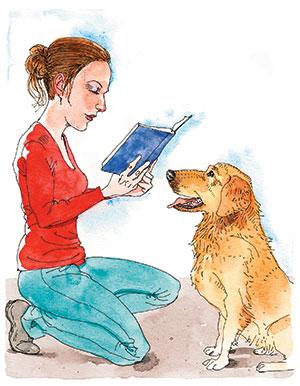
Daniel Kopp remembers when he first saw Lulu, a German-shepherd mix. Kopp, a patent attorney, had never had a dog before, and he knew he wanted a rescue. “These are dogs that deserve a second chance,” he says. So he’d gone to the Washington Animal Rescue League in August 2012 hoping to find the right match. “She caught me with a sweet look, and I stopped in my tracks,” says Kopp, who sensed a gentle nature that would be a good match for his sons, ages nine and six. Kopp brought Lulu back to his home in DC’s Bloomingdale that day.
With about 6 million dogs and cats entering shelters in the United States each year, adopting is a worthwhile endeavor. However, it’s not without challenges. Dogs in shelters sometimes have troubled pasts—abuse and neglect are extreme cases, but even an animal given up by a family can suffer emotional damage. The stress accompanying these experiences can lead to fear, aggression, antisocial behavior, skittishness, or other problems.
All dogs at WARL are given an assessment by behavior-and-training director Alexandra Dilley and her staff. How does the animal react when a human walks into the room? Does the dog know obedience commands such as “sit” or “shake”? The assessment helps trainers tailor their therapy to the animal’s specific personality and needs. An especially nervous dog may benefit from breathing exercises (in which a biscuit rewards deep breaths, leading to positive associations with calm behavior); a dog with boundless energy could warrant longer walks. Staff and volunteers also read books and magazines to the animals daily—hearing a calm voice readies a dog for life in a family’s home, Dilley says.
On average, most dogs spend about two weeks at WARL while the behavior-and-training team makes sure they can safely be around people. Once dogs are deemed ready for adoption, it’s up to a potential owner to pick one that’s right for his or her lifestyle. Because so many shelter dogs are mutts, it’s hard to predict temperament from breed alone; experts say to focus instead on size and energy level. If you don’t have time for two walks a day, consider an older, lower-key dog. Training for a marathon? A high-energy companion could be a great choice.
Soon after Lulu moved in with Kopp and his family, there were problems. She seemed stressed out and had accidents in the house. On walks, she was overly energetic, dragging Kopp behind her, and sometimes was aggressive toward other dogs. “We wanted to really love this dog,” Kopp says, “but we were getting frustrated.”
He called Dilley, who suggested he and Lulu take a basic manners class at WARL, which teaches owners how to interact with their dogs, thereby making obedience training easier. While that class calmed Lulu and helped Kopp get her to sit and stay on command, walks still proved challenging. Six months later, he and Lulu went through WARL’s reactive-dog class, which emphasizes on-leash behavior.
No matter where you adopt, both WARL and the Washington Humane Society offer hotlines for behavior and training questions (WARL, 202-375-7744; WHS, 202-723-5730 ext. 122). Dilley recommends calling as soon as problems arise.
As in any relationship, it’s important to compromise and have realistic expectations. “You have to understand this is not a machine,” Dilley says. “This is not something for which you can just type in a key code and it starts to behave completely differently.”
Kopp concedes that Lulu will probably always be a little restless, but the classes have made her more comfortable around people. Now when his sons climb over and under her, she takes it in stride. With the right help, Lulu has grown into the gentle, loving dog Kopp first saw at the shelter—and a wonderful addition to his family.
This article appears in the January 2014 issue of Washingtonian.

















